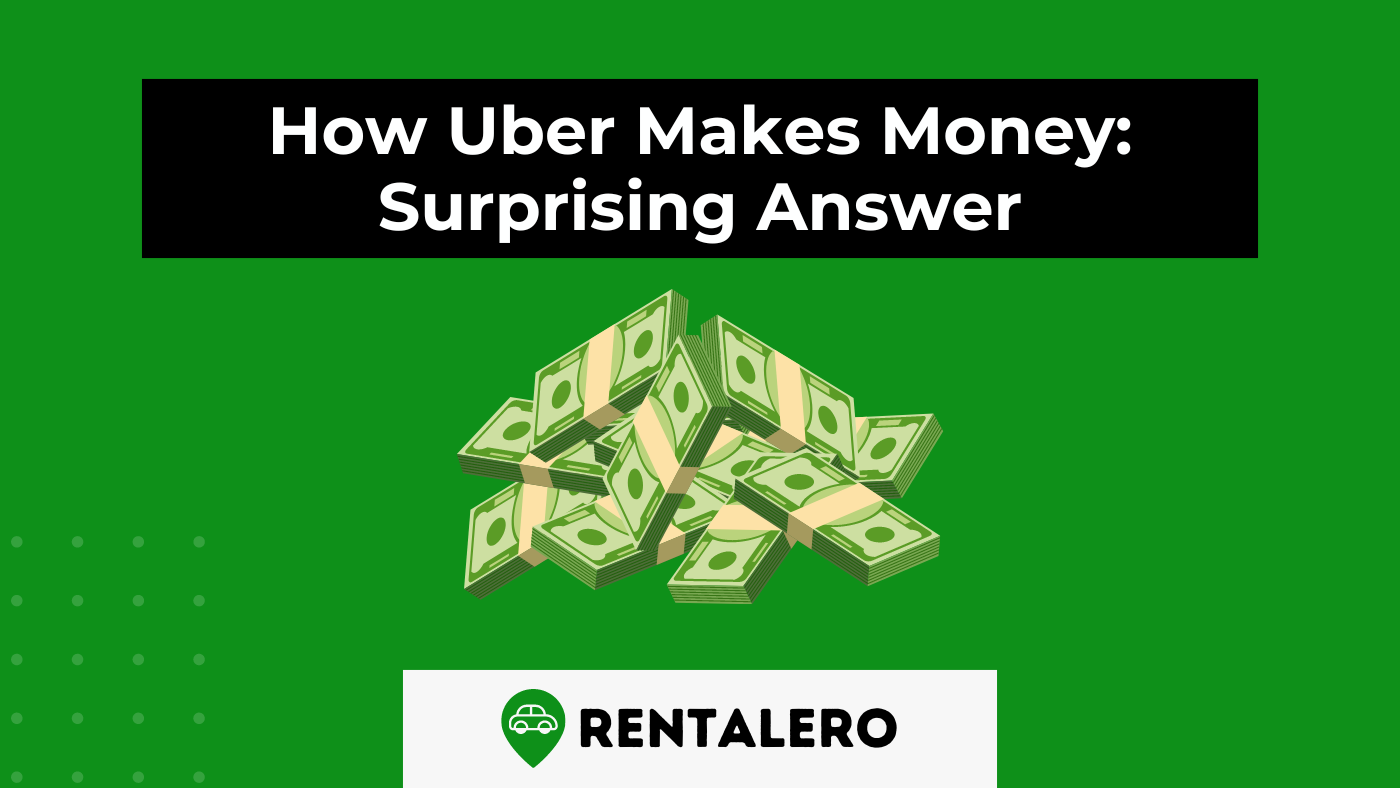Uber’s services are as diverse as they are popular, but how do they make money?
In this post, we’ll explore the key to comprehending the success of this global platform. We’ll answer questions like:
- How does Uber’s commission system work?
- What roles do delivery and freight services play in Uber’s revenue?
- And what other strategies does Uber use to maximize profits?
In plain words, you’ll have a solid understanding of how Uber makes its money. Knowing this could help you make smarter decisions as an Uber user, partner, or potential investor.
Advertising links are marked with *. We receive a small commission on sales, nothing changes for you.
Key Takeaways
- Uber earns revenue through various services, primarily by retaining 20% of ride fares and collecting fees from food delivery and freight services.
- The company’s dynamic pricing model adjusts ride costs based on demand and driver availability, ensuring a balance between affordability for riders and profitability for drivers.
- Uber tailors its services to meet local demands in different regions, such as offering auto-rickshaws in India and economical UberGo rides in various countries.
- Uber has introduced a fuel surcharge to help drivers with increasing fuel costs and has also created beneficial agreements with contractors for better working conditions to sustain business growth.
- Uber’s success lies in its diversified strategies, adaptability, and commitment to balancing the needs of both customers and workers, making it a key player in the global transport industry.
Main ways Uber generates revenue
Uber doesn’t depend on one stream for its income; it diversifies its earnings across multiple channels, leveraging its broad range of services. Here’s how each of them adds up to Uber’s earnings.
Commissions on Trips
First and foremost, we have Uber’s primary service – ride-hailing. Each time you take an Uber ride, the company retains a portion of the fare you pay. Specifically, Uber keeps 20% of the commission while the driver receives the rest or 80%.
So, if your trip costs you $10, Uber takes $2 out of it, leaving $8 for the driver.
This commission covers Uber’s operational costs, such as app development, marketing, and customer support, ensuring the smooth functioning of the platform.
Delivery Fees
Along with transporting people, Uber also delivers food to your doorstep with Uber Eats. Interestingly, this food delivery service has become a major source of income for the company.
When you order your favorite dish, Uber charges a delivery fee. This fee helps Uber cover costs related to maintaining the delivery infrastructure and compensating drivers.
In addition, restaurants using the platform must pay Uber a service fee, which further supplements the company’s revenue.
Freight Fees
Uber Freight, which saw significant growth in 2021, works by charging businesses a fee to haul their goods, similar to how riders pay for their trips. This provides yet another steady stream of income for the company.
Advanced Technology
Last but not least, Uber is betting on the future with its investments in advanced technology. It’s currently developing and refining services like autonomous driving and electric scooters.
While these ventures might not be big earners right now, they’re part of Uber’s long-term growth strategy, positioning the company for future profitability.
Uber’s Pricing Model
Uber’s Pricing Model calculates the cost of your ride, and it’s more dynamic than you might think. With a focus on meeting demand and maximizing driver availability, Uber’s pricing adjusts to suit the circumstances.
Dynamic Pricing and its Elements
Uber uses what’s called dynamic pricing. Simply put, the price of a ride fluctuates based on two main factors: demand for rides and the availability of drivers.
The price increases when there is high demand, during rush hours, or in bad weather. This increase is known as surge pricing. The idea is to encourage more drivers to hit the road when riders need them the most.
Similarly, the price decreases if there are plenty of drivers but not enough riders. This reduction aims to attract more riders and keep the drivers busy. It’s a careful balancing act that ensures riders and drivers get a fair deal.
Regional Differences in Uber Services
Uber’s global presence means it has to adapt to local markets, which is reflected in its pricing model. For example, Uber Auto, a service that utilizes auto-rickshaws, is an affordable and popular option in India.
On the other hand, UberGo, a low-cost ride option in several countries, uses small, fuel-efficient cars to offer economical rides.
The pricing for these services is tweaked to match the local economy, ensuring Uber remains an attractive option for commuters no matter where they are.
This flexibility in service offerings and pricing strategy makes Uber a global player. It can compete with local transport services by meeting the unique needs of different regions while maintaining its profit margins.
Additional Revenue Sources and Strategies
Uber, always one step ahead, seeks out innovative ways to keep the business thriving. From introducing a fuel surcharge to creating beneficial agreements with ride-hail and food-delivery contractors, Uber remains adaptable.
Fuel Surcharge Initiative
In response to global increases in fuel prices in 2022, Uber took a bold step. The company introduced a fuel surcharge, a small extra fee for every ride, and food delivery.
This addition supports drivers and couriers, helping them cover the rising fuel costs.
The surcharge varies based on regional fuel prices and vehicle type, but it goes directly to the drivers and couriers. So, if you’ve noticed a tiny bump in your Uber charges, it’s for this reason.
This approach balances the need to keep rides affordable for customers while ensuring drivers aren’t shouldering the fuel cost burden alone.
Building Stronger Ties with Contractors
In a ground-breaking move, Uber inked an agreement with Canada’s largest service-sector union in 2021. This arrangement enables ride-hailing and food-delivery contractors to have a more direct say in their earnings and work conditions.
The agreement doesn’t mean drivers and couriers are union members but benefits them. For instance, they can now negotiate for better earnings and dispute settlements.
This strategy strengthens Uber’s relationship with its workforce and improves the overall service quality by ensuring a motivated and satisfied team.
Conclusion
Uber’s financial success comes from a clever mix of strategies. They’re not just a ride-hailing service; they’ve branched out into food delivery, freight, and future tech. They keep a chunk of every fare, delivery fee, and freight charge.
Plus, they’ve taken steps like adding a fuel surcharge and negotiating better contractor terms. Their pricing model is dynamic, adjusting to match rider demand and driver supply. They’ve also adapted to fit into different regions around the world.
Understanding Uber’s money-making strategies could help you use their services smarter or inspire your business strategies. After all, learning from the pros is a smart move.
Frequently Asked Questions
How does Uber make most of its money?
Uber’s main source of income is from its ride-hailing service, where it retains 20% of each ride’s fare. However, it also earns significant revenue from delivery fees through Uber Eats and freight fees via Uber Freight.
What is Uber’s fuel surcharge?
The fuel surcharge, introduced in 2022, is an extra fee that Uber adds to every ride and food delivery. This surcharge helps drivers and couriers manage the increasing fuel costs, with the entire amount going directly to them.
What is Uber’s agreement with Canada’s largest service-sector union about?
The agreement allows Uber’s ride-hail and food-delivery contractors to have a say in their earnings and working conditions. It strengthens the relationship between Uber and its contractors, leading to better service quality.
How does Uber’s dynamic pricing work?
Dynamic pricing changes the cost of an Uber ride based on the demand for rides and the availability of drivers. During high demand times or bad weather (known as surge pricing), prices rise to encourage more drivers to be available. If there are more drivers than riders, prices decrease to attract more customers.
Does Uber adjust its services for different regions?
Yes, Uber modifies its services to meet the specific demands of different regions. For instance, it offers auto-rickshaws through Uber Auto in India and provides economical rides with small, fuel-efficient cars through UberGo in various countries.

Nzoputa has been writing for Rentalero since day one and is one of our most experienced members when it comes to the rental industry. For her, nothing beats Uber!
Advertising links are marked with *. We receive a small commission on sales, nothing changes for you.

